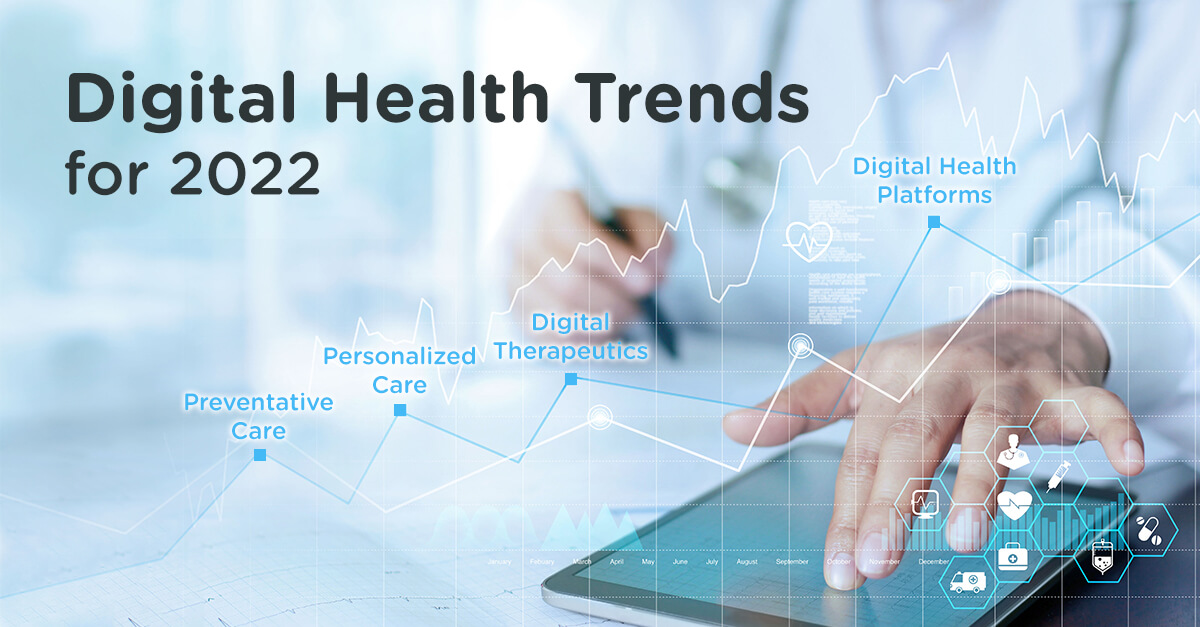2021 has been a challenging year, as the pandemic has continued to place huge pressure on the global healthcare sector’s workforce, infrastructure, and supply chains.
But it’s also been a year of significant innovation. Lessons from the first year of the pandemic as well as changing patient demographics continue to shape the future of healthcare, from how clinicians interact with patients, to the apps and tools they use to monitor and treat them, and the increased importance of data.
The arrival of a new year – and continued uncertainty – will no doubt see this innovation continue. But 2022 is also the year where this innovation will need to be matched with the right systems, processes, and care models to become truly effective, and secure real outcomes for all stakeholders.
To get a clearer picture of what 2022 holds for digital health – and how the year could see innovation turn into real results – we spoke to four of our internal experts to get their views.
Here’s what they had to say.
Jim O'Donoghue, President of
S3 Connected Health
“The past year has seen significant strides for digital health: the establishment of approval and reimbursement pathways for digital solutions in countries like Germany and Belgium – and similar initiatives in France and the UK – could significantly speed up and smooth the adoption of these systems. Elsewhere, significant investment in digital health companies, not to mention mergers and acquisitions shows the huge value in the industry: CB Insights’ 2021 Health Tech Report charts how global healthcare investment rose for the seventh consecutive quarter, surpassing U$34.7 Billion in funding across nearly 1600 deals during 2021 Q1 alone.
In light of those developments, however, 2022 will need to be the ‘year of proof’: that is, the year when these digital health initiatives start to show evidence of adoption and real impact. For pharma and medtech companies, that means focusing on data-driven solutions. Developing more digital therapeutics (DTx) and collecting and using data to improve devices and prove their value will be key.”

John O'Gorman, Product Innovation Manager, at
S3 Connected Health
“The focus over the past year – and beyond – has more often than not been on COVID 19, and rightly so. But it’s important we don’t forget the range of other pressures the healthcare system is under and has been under for some time, which have been exacerbated during the past year.
Chronic diseases remain the leading cause of death and disability worldwide and are one of the biggest drivers of health costs. 40% of Americans now suffer from multiple chronic diseases, and the impact COVID has had on this cohort is yet to be fully realized.
With so many avoiding seeking care during the pandemic, focus on preventive care will be more important than ever in 2022. Preventive care goes beyond just treating diseases once they’re apparent. With the help of digital health tools, preventive care encourages the adoption of healthy lifestyles to stop chronic diseases before they emerge, and monitor at-risk patients to identify symptoms as early as possible.
We’re likely to see continued and increased pressure on hospital beds in 2022. It’s partly due to the chronic health statistics mentioned above but is combined with an aging population and indeed continued fallout from the pandemic. In response to this, predictive analytics can play a key role in assisting hospitals in managing demand, smoothing the flow of patients through medical facilities, and keeping overcrowding in emergency rooms to an absolute minimum.
Finally – as a result of this growing disease prevalence, an aging population, and growing service prices – healthcare costs will continue to rise. The best way for hospitals and health systems to get ahold of these costs is to secure the flow of information, reducing the impact of administrative bottlenecks and costly avoidable readmissions. Investing in tools that boost interoperability is crucial to effectively manage these data flows.”

Bill Betten, Director of Solutions, S3 Connected Health
“From my perspective, this new year will see an upswing in the trend of medtech companies adopting digital therapeutics (DTx) to strengthen their existing device-based offering.
While DTx have been popular with pharma for some time, the potential of DTx has been somewhat underestimated by medtech, as it’s often mischaracterized as standalone, software-only solutions created by the nimblest start-ups.
The real potential of DTx is, in fact, far greater: we need only look at the fact that Philips recently joined the Digital Therapeutics Alliance to see the way the wind is blowing. Medtech companies should now be looking much more closely at these types of products.
Why? Put simply, DTx offer real opportunities for more traditional device-based companies to further develop their capabilities in digital health.
It comes down to really maximizing the potential of device-only offerings with the addition of software, unlocking captured data, and turning it into actionable insights that drive clinically validated improvements to outcomes. These insights are essential to unlocking competitiveness, improving interoperability, and laying the pathway for secure reimbursement in a more value-based system of care – and developments in Germany, Belgium, and elsewhere in Europe, as discussed above, show this process is already underway. Finally, it will hopefully improve the delivery of healthcare and improve patient outcomes as well.”

John Mulcahy, Vice President, Products, S3 Connected Health
“The main hallmark of healthcare in 2021 was undoubtedly the mainstream adoption of remote care models as a result of the pandemic.
As we look forward to 2022, we’ll see the creation of new care pathways that continue to leverage digital solutions as part of mainstream care, not least devices to capture objective patient data, and machine learning to deliver insights to patients and doctors at the point of care.
While we may see an oscillation between in-person and remote care models as a result of new waves and variants of COVID-19, we’re likely to settle at a point that is significantly more digital than what has become before.
This ‘normalization’ of more digital approaches to healthcare will also extend to pharma, where decentralized trials enabled, by technology, will start to become the norm.
While many companies will still create point digital health solutions, there is a clear trend towards adopting a platform approach. Embracing common digital health platforms will enable rapid deployment of digital health solutions across therapies and devices into the future.
These platforms will provide a foundation upon which digital health solutions can be created. Features such as digital health enterprise software, behavior science, data science, and medical devices can be added to any solution created on these platforms to provide data-driven behavior feedback loops, support patients and their care teams, and enable highly engaging and hyper-personalized care.”



